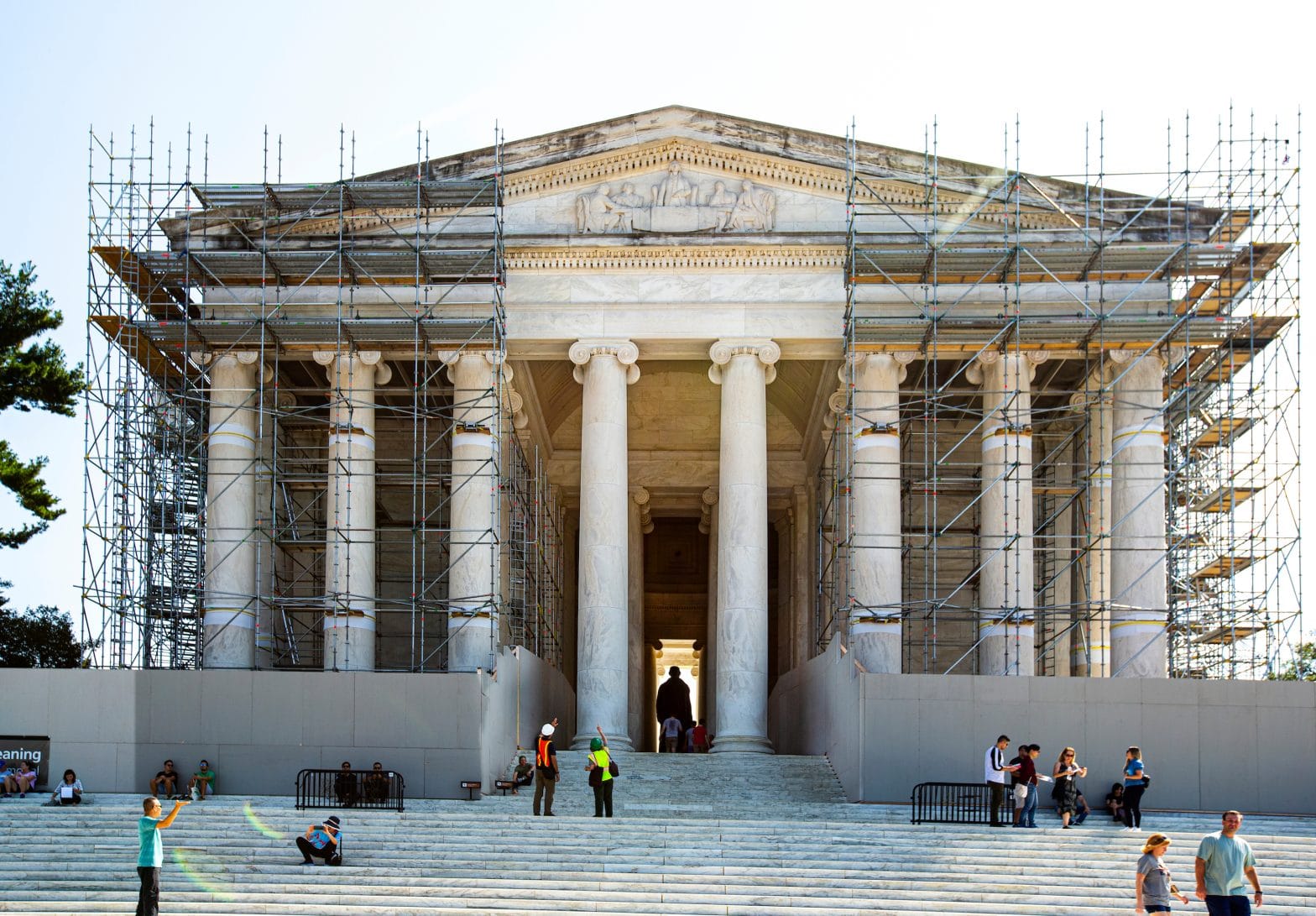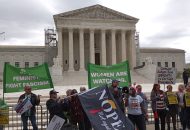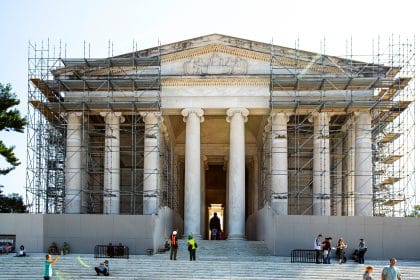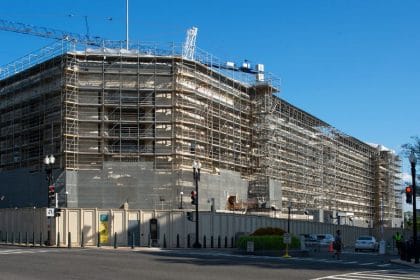Friend or Foe? Washington Is Vexed by an Uninvited Visitor

WASHINGTON — Even in an intrigue-filled capital accustomed to shadowy visitors with vague intentions, one that recently took up residence at a very fancy address here is particularly unnerving.
It arrived without warning and refuses to leave. It moves slowly but stubbornly, like some members of Congress. Government scientists are still trying to sort out if it is friend or foe. Lasers are involved.
Not since a spaceship parked downtown in the 1950s sci-fi classic “The Day the Earth Stood Still” has Washington been so confused by an uninvited guest as it is by the bacteria, fungi and algae creeping over the once-gleaming dome of the Jefferson Memorial, leaving black splotches in its wake.
The outbreak of “biofilm,” as the mysterious microbial mix is known, is more confusing than even Rudolph W. Giuliani.
The Jefferson Memorial and a hallowed shrine at Arlington National Cemetery have been stained with dark blotches. Biofilm is beginning to emerge at several other fabled memorials, including the Washington Monument and Lincoln Memorial, though they have not been visibly marred.
“This thing,” said Audrey Tepper, a National Park Service historic architect who is overseeing the effort to get the stuff off the Jefferson Memorial. “We’ve never seen it before. Now it is everywhere.”
The iconic white dome over the bronze statue of America’s third president and principal drafter of the Declaration of Independence has taken on a ghoulish taint. It might charitably be described as a snow leopard print. Rorschach test gone wrong also works.
The stewards of the memorial, one of Washington’s most popular tourist attractions, first noticed it in the mid-2000s. It looked like mold. But it turned out to be so much more.
Biofilms remain one of the great mysteries of science. They are a swarm of microorganisms that emerge in all sorts of places for all sorts of reasons. The plaque on your teeth? Biofilm. The slippery slime on river rocks? Yup, biofilm.
NASA recently turned to the nerve center of biofilm investigation, the Center for Biofilm Engineering at Montana State University in Bozeman, in its hunt for a remedy to the biofilm creeping through the wastewater pipes of the International Space Station.
The stuff is a scourge in hospitals, contributing to the deaths of tens of thousands of patients each year when the biofilms take up residence on catheters and other medical devices, spawning infection.
Yet obliterating the slimes is not always the way to go. Biofilms also can be forces of good.
Their debut — at least in a form visible to the naked eye — on Washington’s storied monuments has the National Park Service scrambling for a fix. It is diligently probing how and why the biofilm got there, how aggressively to scrape it off, and how likely the discoloration will spread through the nation’s capital.
Standing atop the elaborate scaffold that now shrouds the Jefferson Memorial, Tepper pointed to the intersecting roadways and flight paths nearby. As cars and trucks whizzed by below, a mile-long diesel-powered freight train chugged in the distance and a military helicopter zipped by, headed toward the Pentagon. Jets took off and landed at nearby Reagan National Airport across the Potomac River.
This steady spew of pollution seems an obvious culprit. But the air quality was much worse in the monument’s first few decades — it opened in 1943 — when pollution controls were weak or nonexistent. Tepper noted that a smokestack atop the nearby Bureau of Engraving and Printing belched toxins for years. It’s gone now.
So it just might be that the absence of all that pollution is what the biofilm finds pleasing. No longer, the theory goes, is acid rain attacking it.
“The pollution might have been helping clean it,” Tepper said.
Or maybe this is about climate change. The stepped-up intensity of the sun’s ultraviolet rays could be nourishing the unsightly mass of microbial life that thrives in places that get both moisture and intense light.
Supreme Court, take note if the biofilm comes your way: This is one outbreak for which Justice Louis Brandeis’ famed dictum that sunlight is the best disinfectant does not necessarily apply.
Other suspects? That favorite environmental bogeyman ethanol has emerged. Scientists were surprised to find the chemical compound so popular with Iowa corn farmers may not only help fuel cars, but also may help regenerate biofilm.
Another theory has it that the marble on the memorial has decayed to the point where all the tiny ruts, furrows, nooks and chips welcome the fungi and algae in a way the edifice didn’t in its smoother, shinier days.
“Nothing is ruled out,” said Judy Jacob, a senior Park Service conservator who has been investigating biofilm outbreaks in the Northeast since she first noticed one at a historic cemetery in the Bronx, N.Y. “Everything is possible.”
Even though investigators don’t know the cause, they know the remedy required to make the Jefferson Memorial dome glisten again will not come cheap. A little Ajax and some elbow grease won’t do.
Preservationists are still filled with regret over the damage done when such chemical agents were used to scour historic marble buildings in Italy, France and in the United States decades ago.
Now they worry about anything with more firepower than a garden hose.
The Park Service can’t coat the Jefferson Memorial with zinc oxide — the white stuff used to prevent sunburn and treat diaper rash — which is proving effective at restoring blemished stone near the Tomb of the Unknown Soldier at Arlington National Cemetery. The risk is too high that the inorganic compound would leech into the Tidal Basin that flanks the circular, colonnaded structure. So the federal government is turning to the big guns.
More specifically, lasers.
Workers are methodically burning the film off the dome with handheld lasers, each the size of a laptop. It’s high-tech but slow going. It takes an hour to clean two square feet.
“It is almost like cleaning with a toothbrush,” said Keith Ramsay, the construction management representative at the site. The budget for the project, which also includes other major roof repairs, is north of $8.7 million.
Nobody can guarantee that biofilm won’t stain the dome again once the job is done. Or how many other historic marble monuments and buildings in Washington will be attacked by this aesthetic menace. But in a town that thrives on finding opportunity in crisis, some see potential good news.
“We are trying to look at the whole picture,” said Mary Susan Burnett, a scientist leading a troop of high school students in Alexandria, Va., who are investigating the bewildering outbreak at the memorial. “There are things to think about other than it is making our white marble monument look bad.”
Like whether the swarm of microorganisms has a useful purpose.
At the conveniently named Thomas Jefferson High School for Science and Technology (complete with a facade designed like the memorial), the teenagers tinker with such things as next-generation gene sequencing.
The challenge helped lure Burnett, a self-described “cool bio-instrumentation junkie,” from her job as a cardiovascular disease researcher. Biofilm proved an excellent match for the school’s genetic sequencing apparatus. It enabled her students to produce findings that caught the attention of more pedigreed scientists.
After repeatedly scraping the stone with a scalpel, packing the biofilm samples into dry ice to take back to their lab, and then extracting the DNA for analysis, the class is not so certain the stuff is all bad.
It may be helping preserve the marble — despite its unstylish aesthetic. And some of the bacteria in it might even be useful at solving problems that have nothing to do with the Park Service.
Some of the microbial communities could be relevant to medical science. Perhaps they could be useful in confronting antibiotic resistance or fungal infections.
“There are all kinds of interactions going on between these microbial things all the time,” Burnett said. “Some are predators of other species living in the biofilm. Some graze and eat each other like a cow eating grass. They are trying to protect themselves against each other.”
But taking the long view is a challenge when the stuff is so unsightly.
“The immediate question is: Can we get rid of it,” Burnett said. “But what are we really doing when we get rid of it?”
It is a question consuming scientists in Europe as well.
One Italian biofilm scientist was so intrigued by the Jefferson Memorial outbreak that she made it a focus of a three-year fellowship sponsored by the European Union. She scraped samples of the biofilm from the memorial to be analyzed at the Montana State center and back in Milan, where she discovered it may be helping protect the edifice from water damage.
That’s given pause to some preservationists. They worry that removing the slimes to spiff up the monuments may actually put them at greater risk.
“Are they umbrellas? Are they jackhammers? Are they both?” said Jacob, the Park Service conservator. “We don’t know.”
———
©2019 Los Angeles Times
Visit the Los Angeles Times at www.latimes.com
Distributed by Tribune Content Agency, LLC.




















